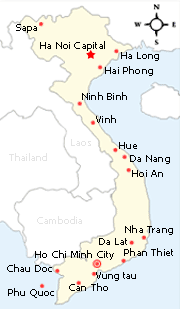|
Ha Noi pagodas lure visitors with rich historical offerings The Tay Phuong and Thay pagodas were among destinations Rett Townsley, a third year recreation management student at the Appalachian State University in Boone, North Carolina, visited during a tour of suburban Ha Noi.
Intrigued: A visitor looks at arhat statues at Tay Phuong Pagoda in Thach Xa village, 30km west of Ha Noi. "It was interesting to see the Buddhist Tay Phuong Pagoda, which is typical of those in the rural areas," said Townsley. The pagoda is renowned for its lacquered wood statues of arhats, considered among Southeast Asia’s most beautiful statues. It was built in the late 16th and early 17th centuries during the Later-Le Dynasty era on Tay Phuong mountain in Thach Xa village, about 30km west of central Ha Noi. The pagoda features three separate two-storey buildings. Built with bricks from Bat Trang village, each has unplastered walls. Each roof has eight apexes, which represent living beings, while carving of dragons, phoenix and flowers enhance rafters and beams. Archways feature a mixture of round and square bricks and the windows are round. "The pagoda is typical of Orient architecture and Buddhism philosophy," said Nguyen Hoang Anh, of Focus Travel company. Pagodas are popular with Vietnamese but a mystery to tourists. "The pagoda attracts visitors because of its long history and arhats". The pagoda has 62 lacquered Buddha wood statues from the 18th century. They feature different expressions of Buddha, who reached the peak of the religion – Nivarna. Sculpture
Neverland: A view from Sai Son Mountain of Thay Pagoda in Quoc Oai district in Ha Noi. The pagoda was built to honour Zen Buddhist Tu Dao Hanh, founder of Vietnamese water puppetry. "Tourists can experience country life and learn more about pagodas during trips around Ha Noi. Pagodas are mainly in rural areas where the pace of life suited Buddhists." The pagoda is the first stop on one-day trip in suburban Ha Noi. Another stop is Thay Pagoda, 8km from Tay Phuong Pagoda. The Thay Pagoda, at the foot of Sai Son Mountain in Quoc Oai district, was built to worship Zen Buddhist Tu Dao Hanh, founder of water puppets in Viet Nam. Built in the 11th century, its small pagodas ha (lower), trung (middle) and thuong (upper) are surrounded by a lake and trees, where Hanh spent his religious life. The pagoda is the biggest and tallest, and has statues for worship of the Zen Buddhist. The upper pagoda’s main gate features two 4m statues made of a mixture of clay, honey, egg and chopped paper and were lacquered more than 500 years ago. They are biggest clay statues in Viet Nam. Most of the statues are made of jack fruit wood, which is popular in northern provinces," said a local guide, Do Thi Huyen. Thay pagoda was a place where Zen Buddhist Tu Dao Hanh meditated and died. He began his religious life in Lang Pagoda in Ha Noi. "Followers flock to the pagoda on the fifth day of the third lunar month when the main festival is held," she said. Local people also wash the statue of the Zen Buddhist, who also introduced wresting and folk games to the area. The Thay Pagoda’s front yard opens to Long Chieu Lake which has a water pavilion in the middle. The pagoda looks like the head of a dragon while the front yard appears as its jaw. Two small bridges link the yard to a small islet and a mountain path. Thay Pagoda is a complex of pagodas. Tu Dao Hanh first meditated on top of Sai Son Mountain, which is home to many caves. "Cac Co cave is known as a place for young people, who love each other and get together during the Spring Festival," the guide said. Townsley made several visits to the water puppet theatre to image what things he saw at the pagoda. "It’s great break from city life. It’s interesting to see Thay Pagoda, where water puppetry originated. I could have spent more time there," Townsley said. For tour information visit www.focusvietnam.com, or email infor@focustravel.com.vn. VietNamNet/Viet Nam News
Other news for Saturday 08 August, 2009 View all news for Saturday 08 August, 2009 on one page News for Friday 07 August, 2009
View all news for Friday 07 August, 2009 on one page Recent News
|











